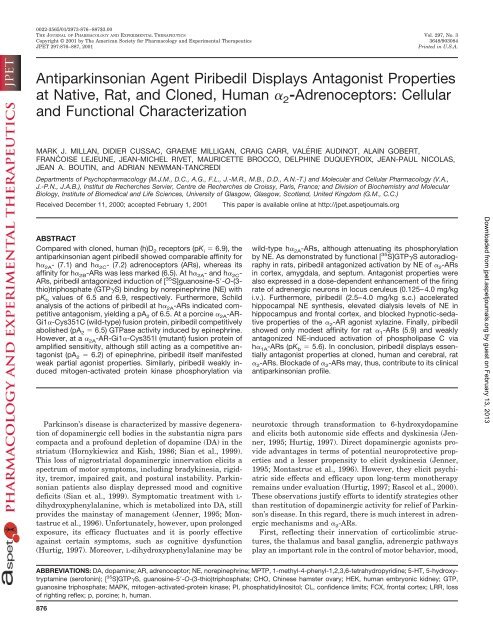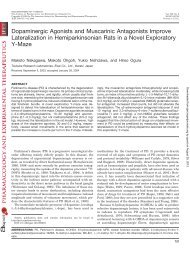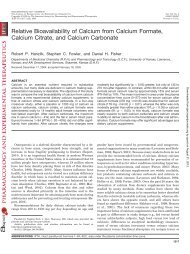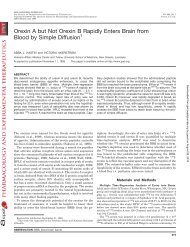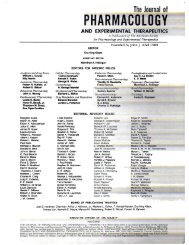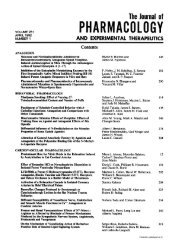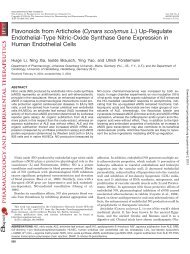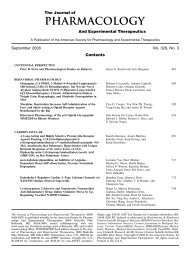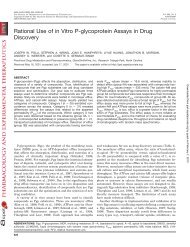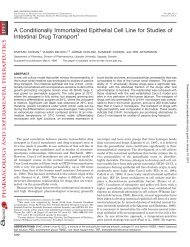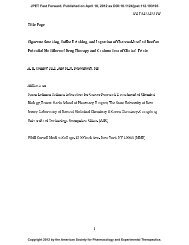Antiparkinsonian Agent Piribedil Displays Antagonist Properties at ...
Antiparkinsonian Agent Piribedil Displays Antagonist Properties at ...
Antiparkinsonian Agent Piribedil Displays Antagonist Properties at ...
You also want an ePaper? Increase the reach of your titles
YUMPU automatically turns print PDFs into web optimized ePapers that Google loves.
0022-3565/01/2973-876–887$3.00<br />
THE JOURNAL OF PHARMACOLOGY AND EXPERIMENTAL THERAPEUTICS Vol. 297, No. 3<br />
Copyright © 2001 by The American Society for Pharmacology and Experimental Therapeutics 3648/903084<br />
JPET 297:876–887, 2001 Printed in U.S.A.<br />
<strong>Antiparkinsonian</strong> <strong>Agent</strong> <strong>Piribedil</strong> <strong>Displays</strong> <strong>Antagonist</strong> <strong>Properties</strong><br />
<strong>at</strong> N<strong>at</strong>ive, R<strong>at</strong>, and Cloned, Human � 2-Adrenoceptors: Cellular<br />
and Functional Characteriz<strong>at</strong>ion<br />
MARK J. MILLAN, DIDIER CUSSAC, GRAEME MILLIGAN, CRAIG CARR, VALÉRIE AUDINOT, ALAIN GOBERT,<br />
FRANĆOISE LEJEUNE, JEAN-MICHEL RIVET, MAURICETTE BROCCO, DELPHINE DUQUEYROIX, JEAN-PAUL NICOLAS,<br />
JEAN A. BOUTIN, and ADRIAN NEWMAN-TANCREDI<br />
Departments of Psychopharmacology (M.J.M., D.C., A.G., F.L., J.-M.R., M.B., D.D., A.N.-T.) and Molecular and Cellular Pharmacology (V.A.,<br />
J.-P.N., J.A.B.), Institut de Recherches Servier, Centre de Recherches de Croissy, Paris, France; and Division of Biochemistry and Molecular<br />
Biology, Institute of Biomedical and Life Sciences, University of Glasgow, Glasgow, Scotland, United Kingdom (G.M., C.C.)<br />
Received December 11, 2000; accepted February 1, 2001 This paper is available online <strong>at</strong> http://jpet.aspetjournals.org<br />
ABSTRACT<br />
Compared with cloned, human (h)D 2 receptors (pK i � 6.9), the<br />
antiparkinsonian agent piribedil showed comparable affinity for<br />
h� 2A- (7.1) and h� 2C- (7.2) adrenoceptors (ARs), whereas its<br />
affinity for h� 2B-ARs was less marked (6.5). At h� 2A- and h� 2C-<br />
ARs, piribedil antagonized induction of [ 35 S]guanosine-5�-O-(3thio)triphosph<strong>at</strong>e<br />
(GTP�S) binding by norepinephrine (NE) with<br />
pK b values of 6.5 and 6.9, respectively. Furthermore, Schild<br />
analysis of the actions of piribedil <strong>at</strong> h� 2A-ARs indic<strong>at</strong>ed competitive<br />
antagonism, yielding a pA 2 of 6.5. At a porcine � 2A-AR-<br />
Gi1�-Cys351C (wild-type) fusion protein, piribedil competitively<br />
abolished (pA 2 � 6.5) GTPase activity induced by epinephrine.<br />
However, <strong>at</strong> a � 2A-AR-Gi1�-Cys351I (mutant) fusion protein of<br />
amplified sensitivity, although still acting as a competitive antagonist<br />
(pA 2 � 6.2) of epinephrine, piribedil itself manifested<br />
weak partial agonist properties. Similarly, piribedil weakly induced<br />
mitogen-activ<strong>at</strong>ed protein kinase phosphoryl<strong>at</strong>ion via<br />
Parkinson’s disease is characterized by massive degener<strong>at</strong>ion<br />
of dopaminergic cell bodies in the substantia nigra pars<br />
compacta and a profound depletion of dopamine (DA) in the<br />
stri<strong>at</strong>um (Hornykiewicz and Kish, 1986; Sian et al., 1999).<br />
This loss of nigrostri<strong>at</strong>al dopaminergic innerv<strong>at</strong>ion elicits a<br />
spectrum of motor symptoms, including bradykinesia, rigidity,<br />
tremor, impaired gait, and postural instability. Parkinsonian<br />
p<strong>at</strong>ients also display depressed mood and cognitive<br />
deficits (Sian et al., 1999). Symptom<strong>at</strong>ic tre<strong>at</strong>ment with Ldihydroxyphenylalanine,<br />
which is metabolized into DA, still<br />
provides the mainstay of management (Jenner, 1995; Montastruc<br />
et al., 1996). Unfortun<strong>at</strong>ely, however, upon prolonged<br />
exposure, its efficacy fluctu<strong>at</strong>es and it is poorly effective<br />
against certain symptoms, such as cognitive dysfunction<br />
(Hurtig, 1997). Moreover, L-dihydroxyphenylalanine may be<br />
wild-type h� 2A-ARs, although <strong>at</strong>tenu<strong>at</strong>ing its phosphoryl<strong>at</strong>ion<br />
by NE. As demonstr<strong>at</strong>ed by functional [ 35 S]GTP�S autoradiography<br />
in r<strong>at</strong>s, piribedil antagonized activ<strong>at</strong>ion by NE of � 2-ARs<br />
in cortex, amygdala, and septum. <strong>Antagonist</strong> properties were<br />
also expressed in a dose-dependent enhancement of the firing<br />
r<strong>at</strong>e of adrenergic neurons in locus ceruleus (0.125–4.0 mg/kg<br />
i.v.). Furthermore, piribedil (2.5–4.0 mg/kg s.c.) acceler<strong>at</strong>ed<br />
hippocampal NE synthesis, elev<strong>at</strong>ed dialysis levels of NE in<br />
hippocampus and frontal cortex, and blocked hypnotic-sed<strong>at</strong>ive<br />
properties of the � 2-AR agonist xylazine. Finally, piribedil<br />
showed only modest affinity for r<strong>at</strong> � 1-ARs (5.9) and weakly<br />
antagonized NE-induced activ<strong>at</strong>ion of phospholipase C via<br />
h� 1A-ARs (pK b � 5.6). In conclusion, piribedil displays essentially<br />
antagonist properties <strong>at</strong> cloned, human and cerebral, r<strong>at</strong><br />
� 2-ARs. Blockade of � 2-ARs may, thus, contribute to its clinical<br />
antiparkinsonian profile.<br />
neurotoxic through transform<strong>at</strong>ion to 6-hydroxydopamine<br />
and elicits both autonomic side effects and dyskinesia (Jenner,<br />
1995; Hurtig, 1997). Direct dopaminergic agonists provide<br />
advantages in terms of potential neuroprotective properties<br />
and a lesser propensity to elicit dyskinesia (Jenner,<br />
1995; Montastruc et al., 1996). However, they elicit psychi<strong>at</strong>ric<br />
side effects and efficacy upon long-term monotherapy<br />
remains under evalu<strong>at</strong>ion (Hurtig, 1997; Rascol et al., 2000).<br />
These observ<strong>at</strong>ions justify efforts to identify str<strong>at</strong>egies other<br />
than restitution of dopaminergic activity for relief of Parkinson’s<br />
disease. In this regard, there is much interest in adrenergic<br />
mechanisms and � 2-ARs.<br />
First, reflecting their innerv<strong>at</strong>ion of corticolimbic structures,<br />
the thalamus and basal ganglia, adrenergic p<strong>at</strong>hways<br />
play an important role in the control of motor behavior, mood,<br />
ABBREVIATIONS: DA, dopamine; AR, adrenoceptor; NE, norepinephrine; MPTP, 1-methyl-4-phenyl-1,2,3,6-tetrahydropyridine; 5-HT, 5-hydroxytryptamine<br />
(serotonin); [ 35 S]GTP�S, guanosine-5�-O-(3-thio)triphosph<strong>at</strong>e; CHO, Chinese hamster ovary; HEK, human embryonic kidney; GTP,<br />
guanosine triphosph<strong>at</strong>e; MAPK, mitogen-activ<strong>at</strong>ed-protein kinase; PI, phosph<strong>at</strong>idylinositol; CL, confidence limits; FCX, frontal cortex; LRR, loss<br />
of righting reflex; p, porcine; h, human.<br />
876<br />
Downloaded from<br />
jpet.aspetjournals.org by guest on February 13, 2013
cognition, and <strong>at</strong>tention (Arnsten et al., 1998; Brefel-Courbon<br />
et al., 1998; Millan et al., 2000a,b,c). Regarding � 2-AR<br />
subtypes, � 2A-ARs are broadly distributed throughout these<br />
regions, � 2B-ARs are largely restricted to the thalamus, and<br />
� 2C-ARs are concentr<strong>at</strong>ed in hippocampus, cortex, and, notably,<br />
stri<strong>at</strong>um (Nicholas et al., 1997). Correspondingly, � 2A-<br />
ARs (and � 2C-ARs) are principally implic<strong>at</strong>ed in the abovespecified<br />
functional roles of adrenergic p<strong>at</strong>hways. Furthermore,<br />
� 2A-ARs predomin<strong>at</strong>e as tonically active, inhibitory autoreceptors<br />
on adrenergic neurons, although a complementary role of<br />
� 2C-AR autoreceptors has also been proposed (Kable et al.,<br />
2000; Millan et al., 2000a,b). � 2A-ARs are also implic<strong>at</strong>ed in<br />
the inhibition of frontocortical and, possibly, subcortical dopaminergic<br />
p<strong>at</strong>hways (Grenhoff and Svensson, 1988; Briley<br />
and Marien, 1994; De Villiers et al., 1995; Millan et al.,<br />
2000a,b,c), as well as corticolimbic serotonergic projections<br />
(Millan et al., 2000a,b,c). Modul<strong>at</strong>ion of dopaminergic and<br />
serotonergic transmission may also, thus, contribute to the<br />
control of motor behavior, mood, and cognition by � 2-ARs.<br />
Second, parkinsonian p<strong>at</strong>ients show a loss of locus ceruleus<br />
localized adrenergic neurons (Hornykiewicz and Kish, 1986;<br />
Sandyk and Iacono, 1990; Brefel-Courbon et al., 1998). This<br />
depletion of NE, which is seen in the cortex (notably in the<br />
motor cortex), in limbic structures (for example, in the nucleus<br />
accumbens), and in the spinal cord, aggrav<strong>at</strong>es the<br />
motor, emotional, cognitive, and sensory deficits of Parkinson’s<br />
disease (preceding cit<strong>at</strong>ions).<br />
Third, � 2-AR antagonists potenti<strong>at</strong>e induction of rot<strong>at</strong>ion<br />
by dopaminergic agonists in r<strong>at</strong>s bearing unil<strong>at</strong>eral lesions of<br />
the substantia nigra (Mavridis et al., 1991a; Chopin et al.,<br />
1999). They also enhance the ability of dopaminergic agonists<br />
to allevi<strong>at</strong>e perturb<strong>at</strong>ion of motor functions provoked by reserpine<br />
and haloperidol (Brefel-Courbon et al., 1998; M.<br />
Brocco, unpublished observ<strong>at</strong>ions). Furthermore, in prim<strong>at</strong>es,<br />
� 2-AR antagonists <strong>at</strong>tenu<strong>at</strong>e motor symptoms elicited<br />
by the neurotoxin 1-methyl-4-phenyl-1,2,3,6-tetrahydropyridine<br />
(MPTP) (Colpaert et al., 1990; Bezard et al., 1999),<br />
whereas lesions of the locus ceruleus exacerb<strong>at</strong>e p<strong>at</strong>hological<br />
changes and delay recovery (Mavridis et al., 1991b; Bing et<br />
al., 1994). Moreover, � 2-AR antagonists facilit<strong>at</strong>e antiparkinsonian<br />
actions of L-dihydroxyphenylalanine in this model<br />
while simultaneously suppressing its dyskinetic side effects<br />
(Bezard et al., 1999; Henry et al., 1999; Grondin et al., 2000).<br />
Fourth, small-scale clinical studies in parkinsonian p<strong>at</strong>ients<br />
suggest a modest improvement upon administr<strong>at</strong>ion of<br />
� 2-AR antagonists (Peyro-Saint-Paul et al., 1997; Ruzicka et<br />
al., 1997). Moreover, Rascol et al. (1997) reported th<strong>at</strong> coadministr<strong>at</strong>ion<br />
of idazoxan improves L-dihydroxyphenylalanine-elicited<br />
dyskinesia.<br />
Collectively, the above-mentioned d<strong>at</strong>a indic<strong>at</strong>e th<strong>at</strong> a deficiency<br />
of adrenergic transmission may contribute to motor,<br />
cognitive, and/or emotional symptoms of Parkinson’s disease,<br />
and th<strong>at</strong> blockade of � 2-ARs (autoreceptors) may be favorable<br />
for its tre<strong>at</strong>ment. However, � 2-AR antagonist properties<br />
alone may be insufficient to control Parkinson’s disease, and<br />
their associ<strong>at</strong>ion with D 2 agonist actions offers a more realistic<br />
prospect for improved tre<strong>at</strong>ment. This might be<br />
achieved by adjunctive use of � 2-AR antagonists with Ldihydroxyphenylalanine<br />
or dopaminergic agents (Brefel-<br />
Courbon et al., 1998; Henry et al., 1999). Altern<strong>at</strong>ively,<br />
� 2-AR antagonist and D 2 agonist properties might be incorpor<strong>at</strong>ed<br />
into a single molecule. In fact, although d<strong>at</strong>a remain<br />
� 2-Adrenoceptors and Parkinson’s Disease 877<br />
fragmentary, certain antiparkinsonian agents do interact<br />
with � 2-ARs. Notably, the ergot deriv<strong>at</strong>ives bromocriptine,<br />
cabergoline, and pergolide. However, they are also potent<br />
agonists <strong>at</strong> 5-hydroxytryptamine (serotonin) (5-HT) 2A and<br />
5-HT 2C receptors, so any role of � 2-ARs in their functional<br />
profiles remains unclear (DeMarinis and Hieble, 1989; Seyfried<br />
and Boettcher, 1990). Furthermore, other agents, such<br />
as talipexole, are efficacious agonists <strong>at</strong> � 2-ARs (Meltzer et<br />
al., 1989; Gessi et al., 1999; A. Newman-Tancredi, unpublished<br />
observ<strong>at</strong>ions).<br />
The dopaminergic agonist piribedil (Trivastal), which is<br />
used clinically for the tre<strong>at</strong>ment of Parkinson’s disease (Rondot<br />
and Ziegler, 1992; Smith et al., 2000), is of particular<br />
interest inasmuch as its arylpiperazine structure differs<br />
markedly from other antiparkinsonian agents. Moreover,<br />
with the exception of weak partial agonist activity <strong>at</strong> h5-<br />
HT 1A receptors, piribedil possesses negligible affinity for serotonergic<br />
receptors and other sites (Dourish, 1983; DeMarinis<br />
and Hieble, 1989; Seyfried and Boettcher, 1990; A.<br />
Newman-Tancredi, unpublished observ<strong>at</strong>ions). To d<strong>at</strong>e, however,<br />
potential actions of piribedil <strong>at</strong> � 2-ARs have not been<br />
evalu<strong>at</strong>ed. The present study undertook, thus, a comprehensive<br />
in vitro and in vivo investig<strong>at</strong>ion of this issue.<br />
M<strong>at</strong>erials and Methods<br />
Binding Studies. Affinities <strong>at</strong> n<strong>at</strong>ive, r<strong>at</strong> D 2 and � 2-ARs, cloned<br />
h�2A-, h� 2B-, and h� 2C-ARs, as well as other sites, were determined<br />
using conventional procedures described in detail elsewhere (Millan<br />
et al., 2000b,c). Conditions are summarized in Table 1. Isotherms<br />
were analyzed by nonlinear regression analysis and IC 50 values<br />
calcul<strong>at</strong>ed using the program PRISM (GraphPad Software, San Diego,<br />
CA). IC 50 values were converted into K i values in accordance<br />
with the equ<strong>at</strong>ion K i � IC 50/(1 � L/K d), where L corresponds to the<br />
radioligand concentr<strong>at</strong>ion and K d is its dissoci<strong>at</strong>ion constant.<br />
Modul<strong>at</strong>ion of [ 35 S]GTP�S Binding <strong>at</strong> Cloned, CHO-Expressed<br />
h� 2-AR Subtypes. The procedure used has been documented<br />
in detail elsewhere (Millan et al., 2000b,c). Briefly,<br />
[ 35 S]GTP�S (1000 Ci/mmol; Amersham Pharmacia Biotech, Les Ulis,<br />
France) was used <strong>at</strong> a concentr<strong>at</strong>ion of 0.1 nM. Samples (containing<br />
50 �g of protein) were incub<strong>at</strong>ed for 60 min <strong>at</strong> 22°C. The buffer<br />
composition was as follows: 20 mM HEPES (pH 7.4), 100 mM NaCl,<br />
3 �M GDP, and 3 mM MgSO 4. Incub<strong>at</strong>ions were termin<strong>at</strong>ed by rapid<br />
filtr<strong>at</strong>ion through Wh<strong>at</strong>man GF/B filters using a Filter Harvester<br />
(Packard, Meriden, CT). Radioactivity retained on the filters was<br />
quantified by liquid scintill<strong>at</strong>ion counting. <strong>Antagonist</strong> properties of<br />
piribedil against fixed concentr<strong>at</strong>ions of NE, IC 50 values were determined,<br />
and the K b calcul<strong>at</strong>ed as described previously (Newman-<br />
Tancredi et al., 1998). In additional antagonist studies, the concentr<strong>at</strong>ion-response<br />
curve for NE was performed in the presence of<br />
incremental concentr<strong>at</strong>ions of piribedil and Schild Analysis performed<br />
to yield pA 2 values.<br />
Actions <strong>at</strong> Cerebral � 2-ARs: [ 35 S]GTP�S Autoradiography.<br />
[ 35 S]GTP�S autoradiography was carried out as described by Newman-Tancredi<br />
et al. (2000). Briefly, slides with three to four brain<br />
sections were incub<strong>at</strong>ed for 60 min in 50 mM HEPES (pH 7.5), 150<br />
mM NaCl, 0.2 mM EGTA, 0.2 mM dithiothreitol, 2.5 mM GDP, 10<br />
mM MgCl 2, 0.05 nM [ 35 S]GTP�S, plus agonist/antagonist ligands.<br />
Following incub<strong>at</strong>ion, sections were washed with ice-cold buffer and<br />
then dipped into ice-cold deionized distilled w<strong>at</strong>er. The slides were<br />
dried and placed in X-ray cassettes apposed to 35 S sensitive film.<br />
Binding densities were measured by computerized densitometry and<br />
14 C standard Microscales.<br />
Actions <strong>at</strong> Porcine (p)� 2A-AR Fusion Proteins. Fusion proteins<br />
were constructed and (transiently) expressed as detailed pre-<br />
Downloaded from<br />
jpet.aspetjournals.org by guest on February 13, 2013
878 Millan et al.<br />
TABLE 1<br />
Affinities (pK is values) of piribedil <strong>at</strong> diverse adrenoceptor subtypes and rel<strong>at</strong>ed sites<br />
D<strong>at</strong>a are means � S.E.M. of three to four determin<strong>at</strong>ions.<br />
Receptor Species Tissue Radioligand <strong>Piribedil</strong><br />
D2 R<strong>at</strong> Stri<strong>at</strong>um<br />
nM<br />
[ 3 H]Spiperone (0.2) 6.74 � 0.11<br />
D2 Human CHO [ 125 I]Iodosulpride (0.1) 6.88 � 0.03<br />
�2 R<strong>at</strong> Cortex [ 3 H]RX821,002 (0.4) 6.36 � 0.07<br />
�2A Human CHO [ 3 H]RX821,002 (0.8) 7.05 � 0.19<br />
�2B Human CHO [ 3 H]RX821,002 (4.0) 6.54 � 0.02<br />
�2C Human CHO [ 3 H]RX821,002 (0.6) 7.16 � 0.12<br />
�1 R<strong>at</strong> Frontal cortex [ 3 H]Prazosin (0.2) 5.37 � 0.06<br />
�1A Human CHO [ 3 H]Prazosin (0.1) 6.09 � 0.08<br />
�1B Human CHO [ 3 H]Prazosin (0.1) 5.21 � 0.07<br />
�1D Human CHO [ 3 H]Prazosin (0.1) 6.66 � 0.11<br />
�1 Human Sf9 [ 3 H]CGP12177 (0.15) �5.0<br />
�2 Human Sf9 [ 3 H]CGP12177 (0.15) �5.0<br />
NET R<strong>at</strong> Brain [ 3 H]Nisoxetine (2.0) �5.0<br />
NET Human CHO [ 3 H]Nisoxetine (2.0) �5.0<br />
MAO A R<strong>at</strong> Brain [ 3 H]RO41-1049 (5.0) �5.0<br />
MAO B R<strong>at</strong> Brain [ 3 H]RO19-6327 (15) �5.0<br />
NET, NE transporter; MAO, monoamine oxidase.<br />
viously (Jackson et al., 1999). Briefly, Gi1� was coupled to the<br />
p� 2A-AR (a generous gift of L. E. Limbird, Vanderbilt University,<br />
Nashville, TN) and spliced into the KpnI and EcoRI sites of the<br />
eukaryotic expression vector pcDNA to yield p� 2A-AR-Gi1� fusion<br />
proteins in pCDNA3. HEK293 cells were grown to confluency (18–24<br />
h) before transfection with pcDNA3 (2.5–2.8 �g). Two days following<br />
transfection, cells were harvested. Three different Gi1� sequences<br />
were used: the wild-type (cysteine) (Cys351C) form, a Cys351G (glycine)<br />
mutant, and a Cys351I (isoleucine) mutant. Cells expressing<br />
the two mutant forms were tre<strong>at</strong>ed for 24 h before harvesting with<br />
pertussis toxin (50 ng/ml). Cells were maintained <strong>at</strong> �80°C and<br />
high-affinity GTPase assays performed on membrane-containing<br />
particul<strong>at</strong>e fractions (Jackson et al., 1999). Nonspecific GTPase activity<br />
was evalu<strong>at</strong>ed in parallel with assays containing GTP (100<br />
�M). Experiments were performed three times on membranes derived<br />
from individual cell transfections.<br />
Influence upon Mitogen-Activ<strong>at</strong>ed Protein Kinase (MAPK)<br />
Activity Coupled to h� 2-ARs. CHO cells expressing h� 2A receptors<br />
were grown as previously described (Millan et al., 2000b,c). For<br />
MAPK determin<strong>at</strong>ions, the procedure was essentially as described in<br />
Cussac et al. (1999). Cells were grown in six-well pl<strong>at</strong>es until confluent.<br />
The cells were then washed twice with serum-free medium<br />
and incub<strong>at</strong>ed overnight in this medium. Drugs were diluted in the<br />
serum-free medium and added to cells to obtain the appropri<strong>at</strong>e final<br />
concentr<strong>at</strong>ion. For antagonist studies, cells were preincub<strong>at</strong>ed for 10<br />
min with <strong>at</strong>ipamezole and then stimul<strong>at</strong>ed with either NE or piribedil<br />
for 5 min. To study the antagonist actions of piribedil, it was<br />
added together with NE for a period of 5 min. At the end of incub<strong>at</strong>ion<br />
periods, 0.25 ml/well of Laemmi sample buffer containing 200<br />
mM dithiothreitol was added. Whole cell lys<strong>at</strong>es were boiled for 3<br />
min <strong>at</strong> 95°C. In experiments with pertussis toxin, cells were tre<strong>at</strong>ed<br />
overnight in serum-free medium with a concentr<strong>at</strong>ion of 100 ng/ml<br />
pertussis toxin. Cell extracts (14 �l) were loaded on 15-well 10%<br />
polyacrylamide gels and “fully” activ<strong>at</strong>ed MAPK was revealed using<br />
a monoclonal antibody specifically raised against the phosphoryl<strong>at</strong>ed<br />
pp42 mapk (extracellular signal receptor-activ<strong>at</strong>ed kinase 2) and<br />
pp44 mapk (extracellular signal receptor-activ<strong>at</strong>ed kinase 1) forms on<br />
both threonine and tyrosine residues (NanoTools, Denzlingen, Germany),<br />
followed by enhanced chemiluminescence detection with<br />
horseradish peroxidase as a secondary antibody (Amersham Pharmacia<br />
Biotech). All autoradiograms were analyzed by computerized<br />
densitometry using AIS software, (Imaging Research, St. C<strong>at</strong>herine’s,<br />
ON, Canada).<br />
<strong>Antagonist</strong> <strong>Properties</strong> <strong>at</strong> h� 1A-ARs: Inhibition of NE-Induced<br />
[ 3 H]Phosph<strong>at</strong>idylinositol (PI) Depletion. The influence<br />
of piribedil upon the activity of phospholipase C coupled to h� 1A-ARs<br />
was determined using [ 3 H]PI depletion. CHO cells were loaded with<br />
[ 3 H]myoinositol and incub<strong>at</strong>ed in 96-well pl<strong>at</strong>es <strong>at</strong> 37°C for 30 min<br />
with NE or piribedil in Krebs-LiCl buffer. For antagonist studies,<br />
cells were preincub<strong>at</strong>ed (5 min) with piribedil prior to NE (30 �M).<br />
Assays were stopped with 0.4 ml of methanol/HCl (88 ml of 100%<br />
methanol � 12 ml of 1 N HCl). Cells were stored <strong>at</strong> �20°C for 2hto<br />
facilit<strong>at</strong>e cell lysis. Pl<strong>at</strong>es were sonic<strong>at</strong>ed for 2 min and membranes<br />
recovered with a Filterm<strong>at</strong>e harvester (Packard) through GF/B filters<br />
impregn<strong>at</strong>ed with 0.1% v/v polyethyleneimine followed by three<br />
washes with distilled, deionized w<strong>at</strong>er. Radioactivity was determined<br />
using a Top-Count micropl<strong>at</strong>e (Packard). In the absence of<br />
NE, �40,000 dpm was typically detected compared with �25,000 in<br />
its presence (30 �M).<br />
Animals. Unless otherwise specified, these studies used male<br />
Wistar r<strong>at</strong>s of 200 to 250 g housed in sawdust-lined cages with<br />
unrestricted access to standard chow and w<strong>at</strong>er. There was a 12-h<br />
light/dark cycle with lights on <strong>at</strong> 7.30 AM. Labor<strong>at</strong>ory temper<strong>at</strong>ure<br />
and humidity were 21 � 0.5°C and 60 � 5%, respectively. Animals<br />
were adapted to labor<strong>at</strong>ory conditions for <strong>at</strong> least a week prior to<br />
testing. All animal use procedures conformed to intern<strong>at</strong>ional European<br />
ethical standards (86/609-EEC) and the French N<strong>at</strong>ional Committee<br />
(décret 87/848) for the care and use of labor<strong>at</strong>ory animals.<br />
Influence upon Electrical Activity Cell Bodies in Locus<br />
Ceruleus. As described previously (Millan et al., 2000b,c), following<br />
anesthesia with chloral hydr<strong>at</strong>e (400 mg/kg i.p.), r<strong>at</strong>s were placed in<br />
a stereotaxic appar<strong>at</strong>us and a tungsten microelectrode lowered into<br />
the locus ceruleus. Coordin<strong>at</strong>es were as follows: AP, �1.2 from zero;<br />
L, 1.2; and DV, �5.5/�6.5 from dura. Neurons were characterized by<br />
1) their distinctive waveform (with a notch on the final ascending<br />
component), and 2) induction upon contral<strong>at</strong>eral paw pinch of an<br />
acceler<strong>at</strong>ion in firing r<strong>at</strong>e followed by a short silence. Following<br />
baseline recording (�5 min), vehicle or piribedil was administered<br />
i.v. (in a volume of 0.5 ml/kg) in cumul<strong>at</strong>ive doses every 2 to 3 min.<br />
Drug effects were quantified over the 60-s bin corresponding to their<br />
time of peak action. Spike2 software (CED, Cambridge, England)<br />
was used for d<strong>at</strong>a acquisition and analysis. D<strong>at</strong>a are expressed as a<br />
percentage of change from baseline firing r<strong>at</strong>e (defined as 0%). D<strong>at</strong>a<br />
were analyzed by two-way ANOVA followed by Newman-Keuls test<br />
for paired d<strong>at</strong>a and the ID 50 values [95% confidence limits (CL)]<br />
calcul<strong>at</strong>ed.<br />
Influence upon Extracellular Levels of NE and 5-HT. As<br />
previously described (Millan et al., 2000b,c), the guide cannula<br />
CMA11 was implanted 1 week prior to experiment<strong>at</strong>ion under pentobarbital<br />
anesthesia (60.0 mg/kg i.p.) <strong>at</strong> the following coordin<strong>at</strong>es:<br />
FCX: AP, �2.2 from bregma; L, �0.6; and DV, �0.2 from dura; and<br />
dorsal hippocampus: AP, �3.6 from bregma; L, �1.2; and DV, �2.3<br />
Downloaded from<br />
jpet.aspetjournals.org by guest on February 13, 2013
from dura. A cuprophane CMA/11 probe (4 mm in length for the FCX<br />
and 2 mm in length for the hippocampus, and 0.24-mm outer diameter)<br />
was lowered into position. Two hours after implant<strong>at</strong>ion, three<br />
basal samples of 20 min each were taken. <strong>Piribedil</strong> or vehicle was<br />
administered and samples were taken for a further 3 h. Levels of NE<br />
and 5-HT were quantified by high-performance liquid chrom<strong>at</strong>ography<br />
followed by coulometric detection (Millan et al., 2000b,c). The<br />
assay limit of sensitivity was 0.1 to 0.2 pg/sample for NE and 5-HT.<br />
D<strong>at</strong>a were analyzed by ANOVA with sampling time as the repe<strong>at</strong>ed<br />
within-subject factor.<br />
Influence upon Cerebral Turnover of NE. Using a procedure<br />
detailed previously (Millan et al., 2000c), NE turnover was determined<br />
in the hippocampus, a structure enriched in NE compared<br />
with DA. The influence of piribedil and vehicle was evalu<strong>at</strong>ed 60 min<br />
following their administr<strong>at</strong>ion and 30 min following injection of the<br />
decarboxylase inhibitor NSD1015 (100 mg/kg s.c.). Tissue levels of<br />
L-dihydroxyphenylalanine were determined by high-performance liquid<br />
chrom<strong>at</strong>ography and electrochemical detection as previously<br />
(Millan et al., 2000b). The influence of piribedil upon levels of Ldihydroxyphenylalanine<br />
was expressed rel<strong>at</strong>ive to vehicle (defined<br />
as 100%). D<strong>at</strong>a were analyzed by ANOVA followed by Dunnett’s test.<br />
Influence upon � 2-AR-Medi<strong>at</strong>ed Sed<strong>at</strong>ion: Loss of Righting<br />
Reflex (LRR) in R<strong>at</strong>s. The LRR in r<strong>at</strong>s was evalu<strong>at</strong>ed according to<br />
a scoring system described previously (Millan et al., 1994, 2000b).<br />
Briefly, r<strong>at</strong>s were placed on their backs on a lab surface covered with<br />
paper wadding and their ability to right themselves was assessed as<br />
follows: score 0, normal, complete righting reflex; score 1, <strong>at</strong>tempted<br />
righting reflex, turn of <strong>at</strong> least 90 degrees; score 2, <strong>at</strong>tempted righting<br />
reflex, turn of less than 90 degrees; and score 3, total LRR, no<br />
<strong>at</strong>tempt to turn. Xylazine (40.0 mg/kg i.p.) or vehicle was administered<br />
30 min prior to determin<strong>at</strong>ion of the LRR, and piribedil or<br />
vehicle was injected 30 min before xylazine. D<strong>at</strong>a were analyzed<br />
nonparametrically. For induction of LRR, the percentage of r<strong>at</strong>s<br />
displaying a score of 1 or higher was determined. All r<strong>at</strong>s receiving<br />
vehicle showed values of zero. For antagonist studies, the percentage<br />
of animals displaying a score of 2 or less was determined. All (N �<br />
12) r<strong>at</strong>s receiving xylazine yielded values of 3. The ED 50 (95% CL)<br />
was calcul<strong>at</strong>ed.<br />
Drugs. <strong>Piribedil</strong>, HCl, and xylazine were dissolved in sterile w<strong>at</strong>er<br />
and injected s.c. and i.p., respectively. All drugs were synthesized<br />
internally, except NE, which was purchased from Sigma (Quentin<br />
Fallavier, France). Drug doses are in terms of the base.<br />
Results<br />
Binding Profile (Fig. 1; Table 1). <strong>Piribedil</strong> yielded pK i<br />
values of 6.74 and 6.88, respectively, <strong>at</strong> stri<strong>at</strong>al, r<strong>at</strong> D 2 receptors<br />
and cloned, CHO-transfected hD 2 receptors. At n<strong>at</strong>ive,<br />
r<strong>at</strong>, cortical � 2-ARs, piribedil showed a pK i of 6.36.<br />
Furthermore, the affinity of piribedil for cloned, h� 2A-ARs<br />
(pK i � 7.05) was slightly higher than its affinity <strong>at</strong> hD 2<br />
Fig. 1. Interaction of piribedil <strong>at</strong> n<strong>at</strong>ive, r<strong>at</strong> (cortical) � 2-ARs, compared<br />
with n<strong>at</strong>ive, r<strong>at</strong> (stri<strong>at</strong>al) D 2 receptors and <strong>at</strong> cloned, hD 2 compared with<br />
h� 2A-ARs. D<strong>at</strong>a show isotherms for displacement of [ 3 H]raclopride binding<br />
to D 2 receptors and displacement of [ 3 H]RX821,002 binding to � 2-ARs.<br />
D<strong>at</strong>a are represent<strong>at</strong>ive of <strong>at</strong> least three experiments, each of which was<br />
performed in triplic<strong>at</strong>e.<br />
� 2-Adrenoceptors and Parkinson’s Disease 879<br />
receptors. <strong>Piribedil</strong> likewise manifested marked affinity for<br />
h� 2C-ARs (7.16). However, it showed somewh<strong>at</strong> lower affinity<br />
for h� 2B-AR (6.54). At n<strong>at</strong>ive, cortical, r<strong>at</strong> � 1-ARs, the affinity<br />
of piribedil was weak (5.37), and its affinity was similarly<br />
modest <strong>at</strong> h� 1A- and h� 1B-ARs (6.09 and 5.21, respectively),<br />
although it showed higher affinity for h� 1D-ARs (6.66).<br />
<strong>Piribedil</strong> manifested negligible (pK i � �5.0) affinity for<br />
cloned h� 1- and h� 2-ARs, as well as for monoamine oxidases<br />
A and B and n<strong>at</strong>ive, r<strong>at</strong> and cloned, human NE transporters.<br />
<strong>Antagonist</strong> <strong>Properties</strong> <strong>at</strong> CHO-Transfected h� 2-ARs:<br />
Inhibition of NE-Stimul<strong>at</strong>ed [ 35 S]GTP�S Binding<br />
(Figs. 2 and 3). NE elicited a marked (ca. 8-fold) increase in<br />
[ 35 S]GTP�S binding <strong>at</strong> h� 2A-ARs with a pEC 50 value of 6.21,<br />
whereas piribedil, evalu<strong>at</strong>ed over an extensive range of concentr<strong>at</strong>ions,<br />
was inactive. Indeed, piribedil concentr<strong>at</strong>ion dependently<br />
and completely suppressed NE (10 �M) stimul<strong>at</strong>ed<br />
[ 35 S]GTP�S binding with a pK b of 6.50. In addition, in the<br />
presence of incremental concentr<strong>at</strong>ions of piribedil, the concentr<strong>at</strong>ion-response<br />
rel<strong>at</strong>ionship for induction of [ 35 S]GTP�S<br />
binding by NE was progressively shifted in parallel to the<br />
right consistent with competitive antagonism. Schild analysis<br />
yielded a slope (1.1 � 0.1) not significantly different from<br />
unity and a pA 2 value of 6.54 close to its pK i (7.05) and pK b<br />
(6.50). At h� 2C-ARs, NE elicited a 2-fold (pEC 50 � 6.52)<br />
enhancement of [ 35 S]GTP�S binding, which was concentr<strong>at</strong>ion<br />
dependently abolished by piribedil (pK b � 6.87). <strong>Piribedil</strong><br />
did not itself modul<strong>at</strong>e [ 35 S]GTP�S binding. At h� 2B-ARs,<br />
NE elev<strong>at</strong>ed [ 35 S]GTP�S binding by 7.6-fold with a pEC 50 of<br />
6.30, whereas piribedil was inactive. At h� 2B-ARs, in contrast<br />
to h� 2A- and h� 2C-ARs, piribedil only marginally <strong>at</strong>tenu<strong>at</strong>ed<br />
the stimul<strong>at</strong>ory influence of NE, in line with its rel<strong>at</strong>ively<br />
low affinity <strong>at</strong> these sites (vide supra).<br />
Influence upon the High-Affinity GTPase Activity of<br />
p� 2A-AR-Gi1� Fusion Proteins (Figs. 4 and 5). In<br />
HEK293 cells transiently expressing p� 2A-AR-Gi1�-C351C<br />
(wild-type), p� 2A-AR-Gi1�-C351G, or p� 2A-AR-Gi1�-C351I<br />
fusion proteins, the influence of piribedil upon high-affinity<br />
GTPase activity was compared with th<strong>at</strong> of NE, epinephrine,<br />
and the prototypical � 2-AR partial agonist clonidine. Their<br />
maximal effects <strong>at</strong> fixed concentr<strong>at</strong>ions are illustr<strong>at</strong>ed in Fig.<br />
4, and the full concentr<strong>at</strong>ion response for induction of GT-<br />
Pase activity by piribedil <strong>at</strong> the p� 2A-AR-Gi1�-C351I fusion<br />
protein is illustr<strong>at</strong>ed in Fig. 5. At the p� 2A-AR-Gi1�-C351C<br />
fusion protein, NE elicited a marked increase in high-affinity<br />
GTPase activity with a maximal effect defined as 100% and a<br />
pEC 50 of 6.24 � 0.12. Epinephrine similarly was a full agonist:<br />
pEC 50 � 6.89 � 0.10. In contrast, clonidine displayed a<br />
submaximal effect (35 � 1%, pEC 50 � 7.27 � 0.18) lower<br />
than th<strong>at</strong> of NE, whereas piribedil was inactive over a broad<br />
range of concentr<strong>at</strong>ions (10 �9 –10 �4 M). At the “low-sensitivity”<br />
p� 2A-AR-Gi1�-C351G fusion protein, higher concentr<strong>at</strong>ions<br />
of NE and epinephrine also behaved as agonists (pEC 50<br />
� 5.24 � 0.03 and 5.74 � 0.05, respectively), clonidine<br />
showed no virtually agonist activity (2 � 1%), and piribedil<br />
was inactive. On the other hand, <strong>at</strong> a “high-sensitivity” p� 2A-<br />
AR-Gi1�-C351I fusion protein, the maximal stimul<strong>at</strong>ion elicited<br />
by NE (pEC 50 � 6.40 � 0.05) and epinephrine (pEC 50 �<br />
6.90 � 0.13) was marked and clonidine, although still a<br />
partial agonist, showed substantial activity (54 � 2%, pEC 50<br />
� 7.15 � 0.01). In this system, piribedil revealed mild (12 �<br />
1%) partial agonist activity in enhancing GTPase activity<br />
with a pEC 50 of 6.40 � 0.12.<br />
Downloaded from<br />
jpet.aspetjournals.org by guest on February 13, 2013
880 Millan et al.<br />
Fig. 2. Blockade by piribedil of NE-induced [ 35 S]GTP�S binding <strong>at</strong> CHO-transfected h� 2A-, h� 2B-, and h� 2C-ARs. Left, enhancement of [ 35 S]GTP�S<br />
binding by NE compared with piribedil. Right, concentr<strong>at</strong>ion-dependent inhibition of the actions of NE by piribedil. D<strong>at</strong>a are represent<strong>at</strong>ive of <strong>at</strong> least<br />
three experiments, each of which was performed in triplic<strong>at</strong>e.<br />
Antagonism of High-Affinity GTPase Activity of<br />
p� 2AAR-Gi1� Fusion Proteins (Fig. 5). At the p� 2A-AR-<br />
Gi1�-C351I fusion protein, in the presence of incremental<br />
concentr<strong>at</strong>ions of piribedil, the concentr<strong>at</strong>ion response for<br />
enhancement of GTPase activity by epinephrine was displaced<br />
in parallel to the right without any loss of maximal<br />
effect. Schild analysis of these d<strong>at</strong>a yielded a pA 2 of 6.24 �<br />
0.02 and a slope (0.96 � 0.07) not significantly different from<br />
unity, indic<strong>at</strong>ing competitive antagonist properties. Similar<br />
observ<strong>at</strong>ions were obtained (d<strong>at</strong>a not shown) upon Schild<br />
analysis of the antagonist properties of piribedil versus epi-<br />
nephrine <strong>at</strong> the wild-type C351C fusion protein (pA 2 �<br />
6.36 � 0.17) and the C351G mutant (pA 2 � 6.50 � 0.10).<br />
Influence upon MAPK Activity in CHO Cells Transfected<br />
with h� 2A-ARs (Figs. 6 and 7). In CHO cells stably<br />
expressing h� 2A-ARs, NE concentr<strong>at</strong>ion dependently activ<strong>at</strong>ed<br />
(phosphoryl<strong>at</strong>ed) MAPK with a pEC 50 of 7.52 � 0.16.<br />
Clonidine also stimul<strong>at</strong>ed MAPK with an efficacy similar to<br />
th<strong>at</strong> of NE. <strong>Piribedil</strong> concentr<strong>at</strong>ion dependently enhanced<br />
MAPK phosphoryl<strong>at</strong>ion with a pEC 50 of 6.41 � 0.17, although<br />
its maximal effect was only 33 � 7% compared with<br />
NE defined as 100%. Furthermore, piribedil concentr<strong>at</strong>ion<br />
Downloaded from<br />
jpet.aspetjournals.org by guest on February 13, 2013
dependently (and partially) <strong>at</strong>tenu<strong>at</strong>ed the stimul<strong>at</strong>ory action<br />
of NE. The stimul<strong>at</strong>ion elicited by NE, clonidine, and<br />
piribedil was, in each case, abolished by the selective � 2-AR<br />
antagonist <strong>at</strong>ipamezole. Pertussis toxin also abolished the<br />
actions of NE and piribedil.<br />
Inhibition of NE-Activ<strong>at</strong>ed [ 35 S]GTP�S Binding <strong>at</strong><br />
Cerebral � 2-ARs (Figs. 8 and 9). NE (10 �M) elicited a<br />
pronounced increase in [ 35 S]GTP�S binding as quantified in<br />
the insular cortex, amygdala, and l<strong>at</strong>eral septum. This action<br />
of NE was blocked by coincub<strong>at</strong>ion with piribedil (100 �M).<br />
Applied alone, piribedil did not enhance [ 35 S]GTP�S binding.<br />
Indeed, it elicited a mild, although nonsignificant, depression<br />
of basal binding.<br />
<strong>Antagonist</strong> <strong>Properties</strong> <strong>at</strong> h� 1-ARs: Blockade of NE-<br />
Induced [ 3 H]PI Depletion (Fig. 10). In CHO cells stably<br />
expressing h� 1A-ARs, NE elicited a dose-dependent depletion<br />
of membrane-bound [ 3 H]PI, reflecting the positive coupling of<br />
these sites to phospholipase C. In contrast, piribedil did not<br />
modify [ 3 H]PI levels. Indeed, it concentr<strong>at</strong>ion dependently,<br />
albeit weakly, <strong>at</strong>tenu<strong>at</strong>ed the action of NE with a pK b of<br />
5.59 � 0.13.<br />
Activ<strong>at</strong>ion of Locus Ceruleus-Adrenergic Neurons<br />
(Fig. 11). In anesthetized r<strong>at</strong>s, piribedil evoked a dose-dependent<br />
and pronounced increase in the electrical activity of<br />
locus ceruleus-localized, adrenergic cell bodies over a dose<br />
range of 0.125 to 4.0 mg/kg i.v. At its maximally effective dose<br />
(4.0), firing r<strong>at</strong>e was approxim<strong>at</strong>ely doubled rel<strong>at</strong>ive to baseline<br />
values.<br />
Enhancement of Hippocampal Synthesis of NE.<br />
<strong>Piribedil</strong> dose dependently and significantly acceler<strong>at</strong>ed NE<br />
synthesis in the hippocampus, as quantified by determin<strong>at</strong>ion<br />
of its precursor L-dihydroxyphenylalanine in r<strong>at</strong>s pretre<strong>at</strong>ed<br />
with the decarboxylase inhibitor NSD1015. Absolute<br />
levels of L-dihydroxyphenylalanine for vehicle were 0.69 �<br />
0.04 mg/tissue (�100.0 � 5.3%). Expressed rel<strong>at</strong>ive to these<br />
values, the effect of piribedil was as follows: piribedil (2.5<br />
mg/kg s.c.) � 100.2 � 7.1%; piribedil (10.0) � 120.7 � 7.1%;<br />
and piribedil (40.0) � 145.3 � 6.2%; F(3,32) � 9.0, P � 0.001.<br />
Elev<strong>at</strong>ion of Extracellular Levels of NE in Frontal<br />
Cortex and Hippocampus (Fig. 12). <strong>Piribedil</strong> evoked a<br />
dose-dependent (2.5–40.0 mg/kg s.c.) and marked increase in<br />
extracellular levels of NE in the FCX of freely moving r<strong>at</strong>s.<br />
This action was selective inasmuch as levels of 5-HT in the<br />
same samples were not significantly elev<strong>at</strong>ed (d<strong>at</strong>a not<br />
� 2-Adrenoceptors and Parkinson’s Disease 881<br />
Fig. 3. Schild analysis of the concentr<strong>at</strong>ion-dependent antagonism by piribedil of the induction of [ 35 S]GTP�S binding by NE <strong>at</strong> CHO-transfected<br />
h� 2A-ARs. Left, concentr<strong>at</strong>ion-response curve for stimul<strong>at</strong>ion of [ 35 S]GTP�S binding by NE <strong>at</strong> h� 2A-AR in the presence of incremental concentr<strong>at</strong>ions<br />
of piribedil. Right, Schild transform<strong>at</strong>ion of d<strong>at</strong>a. Similar d<strong>at</strong>a were obtained in three experiments, each of which was performed in triplic<strong>at</strong>e.<br />
shown). In the hippocampus, piribedil likewise elicited a<br />
dose-dependent (2.5–40.0 mg/kg s.c.) and significant increase<br />
in levels of NE without influencing those of 5-HT (d<strong>at</strong>a not<br />
shown).<br />
Inhibition of Sed<strong>at</strong>ive-Hypnotic <strong>Properties</strong> of � 2-AR<br />
Agonist Xylazine. Xylazine elicited a complete LRR <strong>at</strong> a<br />
dose of 40.0 mg/kg (mean score � 3.0 � 0.0), whereas piribedil<br />
was devoid of activity (80.0 mg/kg s.c., score � 0.0 � 0.0).<br />
Indeed, piribedil completely (score � 0.0 � 0.0 <strong>at</strong> 80.0 mg/kg,<br />
s.c.) and dose dependently blocked the action of xylazine with<br />
an ED 50 (95% CL) of 32 (21–50) mg/kg s.c.<br />
Discussion<br />
Binding Profile <strong>at</strong> � 2-AR Subtypes Compared with<br />
D 2 Receptors. Although certain agents differenti<strong>at</strong>e r<strong>at</strong><br />
� 2A- from h� 2A-ARs, like the majority of ligands, piribedil<br />
showed similar affinities for these species homologs (Renouard<br />
et al., 1994; Bylund, 1995; Hieble et al., 1995). Furthermore,<br />
although agents distinguishing h� 2A- and h� 2C-<br />
ARs have been documented, like most drugs (preceding<br />
cit<strong>at</strong>ions), the affinity of piribedil for these sites was comparable.<br />
In fact, the affinity of piribedil was slightly less pronounced<br />
<strong>at</strong> h� 2B-ARs. Although this difference was not<br />
marked and any functional significance remains to be elucid<strong>at</strong>ed,<br />
rel<strong>at</strong>ively modest (antagonist) activity <strong>at</strong> h� 2B- versus<br />
h� 2A/2C-ARs was also indic<strong>at</strong>ed by [ 35 S]GTPyS studies discussed<br />
below. Inasmuch as agonist properties of piribedil <strong>at</strong><br />
dopamine D 2 receptors are fundamental to its clinical, antiparkinsonian<br />
properties (Dourish, 1983; Rondot and Ziegler,<br />
1992), it is of importance th<strong>at</strong> its affinities for n<strong>at</strong>ive and<br />
cloned, human � 2-ARs were similar to affinities <strong>at</strong> D 2 sites.<br />
Antagonism of NE-Induced [ 35 S]GTP�S Binding <strong>at</strong><br />
� 2-ARs. Pertussis toxin-sensitive coupling of � 2-ARs to Gi<br />
proteins can be quantified by binding of [ 35 S]GTP�S, which<br />
recognizes the �-subunit of Gi and other G proteins (Jasper et<br />
al., 1998; Newman-Tancredi et al., 1998; Millan et al.,<br />
2000b). In line with its binding profile, piribedil concentr<strong>at</strong>ion<br />
dependently abolished enhancement of [ 35 S]GTP�S<br />
binding by NE <strong>at</strong> h� 2A- and h� 2C-ARs. These antagonist<br />
properties were expressed competitively inasmuch as piribedil<br />
displaced the concentr<strong>at</strong>ion-response curve for NE <strong>at</strong><br />
h� 2A-ARs in parallel to the right. Autoradiographical techniques<br />
allowing visualiz<strong>at</strong>ion of � 2-AR-coupled G proteins in<br />
Downloaded from<br />
jpet.aspetjournals.org by guest on February 13, 2013
882 Millan et al.<br />
Fig. 4. Actions of piribedil <strong>at</strong> HEK293 cell-transfected p� 2A-AR-Gi1�<br />
fusion proteins, as determined by a high-affinity GTPase assay. A, induction<br />
of high-affinity GTPase activity by piribedil compared with NE,<br />
epinephrine (EPI), and clonidine <strong>at</strong> a wild-type p� 2A-AR-Gi1�-Cys351C<br />
fusion protein. B, induction of high-affinity GTPase activity <strong>at</strong> a mutant<br />
p� 2A-AR-Gi1�-Cys351G fusion protein. C, induction of high-affinity GT-<br />
Pase activity <strong>at</strong> a mutant p� 2A-AR-Gi1�-Cys359I fusion protein. D<strong>at</strong>a are<br />
from represent<strong>at</strong>ive experiments performed in triplic<strong>at</strong>e, which were<br />
repe<strong>at</strong>ed on two separ<strong>at</strong>e occasions with identical results.<br />
cerebral tissue have recently been developed (Happe et al.,<br />
2000). This approach demonstr<strong>at</strong>ed th<strong>at</strong>, like the selective<br />
� 2-AR antagonist <strong>at</strong>ipamezole (Newman-Tancredi et al.,<br />
Fig. 5. Concentr<strong>at</strong>ion-dependent influence of piribedil upon high-affinity<br />
GTPase activity <strong>at</strong> a mut<strong>at</strong>ed p� 2A-AR-Gi1�-Cys351I fusion protein, and<br />
inhibition of the action of epinephrine (EPI). A, concentr<strong>at</strong>ion-dependent<br />
facilit<strong>at</strong>ory influence of piribedil. B, displacement of the concentr<strong>at</strong>ionresponse<br />
curve for epinephrine to the right in the presence of incremental<br />
concentr<strong>at</strong>ions of piribedil. C, Schild transform<strong>at</strong>ion of d<strong>at</strong>a from B. D<strong>at</strong>a<br />
are means � S.E.M.s of three independent experiments performed in<br />
triplic<strong>at</strong>e.<br />
2000), piribedil antagonizes induction of [ 35 S]GTP�S binding<br />
by NE in insular cortex, amygdala, and septum. Inasmuch as<br />
these structures possess a high density of � 2A-ARs (Nicholas<br />
et al., 1997), their blockade likely particip<strong>at</strong>es to this action<br />
of piribedil, although a contribution of � 2C-ARs should not be<br />
discounted. In this light, studies of the stri<strong>at</strong>um, which is<br />
Downloaded from<br />
jpet.aspetjournals.org by guest on February 13, 2013
Fig. 6. Influence of piribedil upon MAPK activity <strong>at</strong> cloned CHO-transfected h� 2A-ARs. A, represent<strong>at</strong>ive experiment is presented to illustr<strong>at</strong>e the<br />
compar<strong>at</strong>ive influence of piribedil versus NE upon MAPK activity. B, quantific<strong>at</strong>ion of their actions is displayed. D<strong>at</strong>a are means � S.E.M.s of three<br />
independent experiments. C and D, blockade of the actions of piribedil, clonidine, and NE by the selective � 2-AR antagonist <strong>at</strong>ipamezole and (except<br />
for clonidine) by pertussis toxin is shown. The experiment was performed on three occasions, each yielding identical results.<br />
Fig. 7. Inhibition by piribedil of the induction of MAPK by NE. A,<br />
represent<strong>at</strong>ive experiment is presented to illustr<strong>at</strong>e the inhibitory influence<br />
of piribedil upon the induction of MAPK activity by NE. B, quantific<strong>at</strong>ion<br />
of this inhibitory influence upon the action of NE. D<strong>at</strong>a are<br />
means � S.E.M.s of three independent experiments.<br />
enriched in � 2C-ARs, as well as the locus ceruleus, which<br />
primarily bears � 2A-AR autoreceptors, would be of interest<br />
(Nicholas et al., 1997). Furthermore, it is unclear to wh<strong>at</strong><br />
extent pre- versus postsynaptic � 2-ARs contribute to enhancement<br />
of [ 35 S]GTP�S binding by NE (Happe et al., 2000;<br />
Newman-Tancredi et al., 2000). The tendency of piribedil to<br />
suppress basal [ 35 S]GTP�S binding might be considered indic<strong>at</strong>ive<br />
of inverse agonist properties <strong>at</strong> constitutively active<br />
� 2-ARs (Murrin et al., 2000; Pauwels et al., 2000). However,<br />
this action did not <strong>at</strong>tain st<strong>at</strong>istical significance and cellular<br />
models discussed below suggest th<strong>at</strong> piribedil possesses weak<br />
partial agonist activity <strong>at</strong> h� 2A-ARs. Thus, this modest inhibitory<br />
influence of piribedil upon basal [ 35 S]GTP�S binding<br />
likely reflects residual NE.<br />
Interaction with p� 2A-AR-Gi1� Fusion Proteins. Porcine<br />
� 2A-ARs are homologous to their human counterparts<br />
(Bylund, 1995; Jackson et al., 1999) and piribedil (competitively)<br />
blocked enhancement of GTPase activity by epineph-<br />
� 2-Adrenoceptors and Parkinson’s Disease 883<br />
rine <strong>at</strong> a p� 2A-AR-Gi1�-Cys351C (wild-type) fusion protein,<br />
underpinning the [ 35 S]GTP�S binding studies. The pertussis<br />
toxin-sensitive Cys351 position is important in determining<br />
efficacy of coupling to the Gi protein and a decrease and<br />
increase in hydrophobicity upon replacement of cysteine by<br />
glycine and isoleucine discourages and favors this interaction,<br />
respectively (Jackson et al., 1999). Correspondingly,<br />
intrinsic efficacy of ligands is respectively blunted and amplified<br />
(Fig. 4; Jackson et al., 1999). It is, thus, intriguing<br />
th<strong>at</strong> the Cys351I mutant revealed a modest enhancement in<br />
GTPase activity with piribedil, in analogy to partial agonist<br />
actions of � 2-AR “antagonists” <strong>at</strong> mut<strong>at</strong>ed � 2-ARs (Hieble et<br />
al., 1995; Pauwels et al., 2000). <strong>Piribedil</strong> might, in theory,<br />
stimul<strong>at</strong>e [ 35 S]GTP�S binding <strong>at</strong> wild-type � 2A-ARs under<br />
certain conditions, such as high “receptor reserve” (Hieble et<br />
al., 1995). Since fusion proteins possess an “invariant” 1:1<br />
receptor/G protein stoichiometry, this issue requires evalu<strong>at</strong>ion<br />
with other approaches.<br />
Modul<strong>at</strong>ion of h� 2-AR-Medi<strong>at</strong>ed MAPK Activity. In<br />
line with the l<strong>at</strong>ter possibility, partial agonist properties of<br />
piribedil <strong>at</strong> wild-type h� 2A-ARs were revealed by weak and<br />
pertussis toxin-sensitive phosphoryl<strong>at</strong>ion of MAPK, a response<br />
for which clonidine behaved as a full agonist (Fig. 6)<br />
(Alblas et al., 1993; Kribben et al., 1997). This difference to<br />
[ 35 S]GTP�S/GTPase measures of efficacy <strong>at</strong> wild-type h� 2A-<br />
ARs likely reflects signal “amplific<strong>at</strong>ion” downstream of receptor-G<br />
protein coupling. Nevertheless, in all cellular models,<br />
actions of NE and epinephrine were <strong>at</strong>tenu<strong>at</strong>ed by piribedil.<br />
This is a crucial consider<strong>at</strong>ion inasmuch as NE is spontaneously<br />
released from adrenergic neurons. Indeed, as demonstr<strong>at</strong>ed<br />
both by [ 35 S]GTP�S autoradiography (vide supra)<br />
and functional studies (vide infra), piribedil displays robust<br />
Downloaded from<br />
jpet.aspetjournals.org by guest on February 13, 2013
884 Millan et al.<br />
Fig. 8. Influence of piribedil compared with NE upon [ 35 S]GTP�S binding <strong>at</strong> � 2-ARs localized in the l<strong>at</strong>eral septum. Upper left, basal binding of<br />
[ 35 S]GTP�S. Upper right, binding of [ 35 S]GTP�S in the presence of NE (10 �M). Lower left, binding of [ 35 S]GTP�S in the presence of piribedil (100 �M).<br />
Lower right, inhibitory influence of piribedil upon enhancement of binding by NE. D<strong>at</strong>a are represent<strong>at</strong>ive of four independent experiments. See Fig.<br />
9 for further analysis.<br />
Fig. 9. Inhibition by piribedil of the facilit<strong>at</strong>ory influence of NE upon<br />
[ 35 S]GTP�S binding <strong>at</strong> � 2-ARs localized in l<strong>at</strong>eral (l<strong>at</strong>) septum, insular<br />
cortex (ctx), and amygdala. D<strong>at</strong>a are means � S.E.M.s of four independent<br />
experiments for percentage [ 35 S]GTP�S simul<strong>at</strong>ion rel<strong>at</strong>ive to basal<br />
values, which were defined as 100%. These were 182 � 8, 276 � 37, and<br />
244 � 54 nCi/g tissue equivalent for insular cortex, l<strong>at</strong>eral septum, and<br />
amygdala, respectively. The differences of NE to basal values and of<br />
piribedil/NE to NE values were significant (P � 0.05) in each structure in<br />
a m<strong>at</strong>ched pairs t test.<br />
antagonist properties <strong>at</strong> cerebral � 2-ARs, including highly<br />
sensitive � 2A-AR autoreceptors.<br />
Interaction with � 1-ARs. Although piribedil displayed<br />
antagonist properties <strong>at</strong> h� 1A-ARs, this action was expressed<br />
weakly. Furthermore, in contrast to � 1-AR antagonists,<br />
which interact with excit<strong>at</strong>ory � 1-ARs on raphe serotoninergic<br />
neurons (Millan et al., 2000a), piribedil failed to suppress<br />
dialys<strong>at</strong>e levels of 5-HT (d<strong>at</strong>a not shown). Blockade of � 1-ARs<br />
is, thus, unlikely to play an important role in the functional<br />
actions of piribedil. Indeed, antagonism of � 1-ARs suppresses<br />
r<strong>at</strong>her than facilit<strong>at</strong>es motor function (Mavridis et<br />
al., 1991a; Hayashi and Maze, 1993; Millan et al., 2000b)<br />
(see below).<br />
Modul<strong>at</strong>ion of Ascending Adrenergic Transmission.<br />
Blockade of tonically active � 2-AR autoreceptors increases<br />
electrical activity of adrenergic cell bodies and enhances NE<br />
release and synthesis in terminal structures (Trendelenburg<br />
et al., 1999; Millan et al., 2000a,b,c). Correspondingly, like<br />
� 2-AR antagonists, piribedil excited locus ceruleus neurons,<br />
elev<strong>at</strong>ed extracellular levels of NE in FCX and hippocampus,<br />
and acceler<strong>at</strong>ed hippocampal NE synthesis. Collectively, an<strong>at</strong>omical,<br />
pharmacological, and genetic analyses indic<strong>at</strong>e a<br />
key role of � 2A-ARs in modul<strong>at</strong>ion of adrenergic transmission,<br />
although � 2C-ARs may also contribute (Trendelenburg<br />
et al., 1999; Kable et al., 2000; Millan et al., 2000a,b). In view<br />
of antagonist actions of piribedil <strong>at</strong> both � 2A- and � 2C-sites,<br />
their rel<strong>at</strong>ive importance remains to be elucid<strong>at</strong>ed. Inasmuch<br />
as selective D 2/D 3 agonists do not influence frontocortical<br />
adrenergic p<strong>at</strong>hways (Millan et al., 2000a), activ<strong>at</strong>ion by<br />
piribedil of D 2/D 3 sites cannot underlie its enhancement of<br />
adrenergic transmission. Stimul<strong>at</strong>ion of 5-HT 1A autoreceptors,<br />
by reducing serotonergic transmission, disinhibits frontocortical<br />
adrenergic p<strong>at</strong>hways (Millan et al., 2000a). However,<br />
this mechanism is also unlikely to be relevant since<br />
piribedil shows only low activity <strong>at</strong> 5-HT 1A receptors (Seyfried<br />
and Boettcher, 1990; A. Newman-Tancredi, unpublished<br />
observ<strong>at</strong>ions) and failed to modify extracellular levels<br />
of 5-HT (d<strong>at</strong>a not shown). Finally, although actions <strong>at</strong> �-ARs,<br />
NE transporters and monoamine oxidases influence extracel-<br />
Downloaded from<br />
jpet.aspetjournals.org by guest on February 13, 2013
Fig. 10. Antagonism by piribedil of the depletion of [ 3 H]PI evoked by NE <strong>at</strong> cloned h� 1A-ARs transfected into CHO cells. D<strong>at</strong>a are represent<strong>at</strong>ive of<br />
three independent experiments, each performed in triplic<strong>at</strong>e.<br />
Fig. 11. Influence of piribedil upon the electrical activity of adrenergic<br />
neurons in the locus ceruleus (LC). Top, represent<strong>at</strong>ive neuron th<strong>at</strong><br />
illustr<strong>at</strong>es the dose-dependent increase in firing r<strong>at</strong>e elicited by piribedil.<br />
Bottom, dose-response rel<strong>at</strong>ionship for activ<strong>at</strong>ion of adrenergic neurons is<br />
shown. D<strong>at</strong>a are means � S.E.M, N � 5. ANOVA as follows. F(4,24) � 8.4,<br />
P � 0.01. *P � 0.05 to vehicle (VEH) values in Newman-Keuls test.<br />
lular levels of NE (Millan et al., 2000a), piribedil showed<br />
negligible affinity for these sites.<br />
Influence upon � 2-AR-Medi<strong>at</strong>ed Sed<strong>at</strong>ion. Engagement<br />
of � 2-AR autoreceptors elicits sed<strong>at</strong>ion (Hayashi and<br />
Maze, 1993; Millan et al., 1994, 2000b; Kable et al., 2000)<br />
and, in analogy to other � 2-AR antagonists, piribedil suppressed<br />
induction of LRR by xylazine. In distinction, � 1-AR<br />
antagonists enhance sed<strong>at</strong>ive actions of � 2-AR agonists (Hayashi<br />
and Maze, 1993; Millan et al., 2000b). Correspondingly,<br />
these d<strong>at</strong>a emphasize th<strong>at</strong> � 2-AR antagonist properties of<br />
piribedil outweigh its weak blockade of � 1-ARs. Activ<strong>at</strong>ion of<br />
D 2/D 3 receptors is unlikely to be involved since dopaminergic<br />
agonists only variably and submaximally <strong>at</strong>tenu<strong>at</strong>e hypnotic<br />
sed<strong>at</strong>ive actions of xylazine (M. Brocco, unpublished observ<strong>at</strong>ions).<br />
� 2-Adrenoceptors and Parkinson’s Disease 885<br />
Fig. 12. Influence of piribedil upon extracellular levels of norepinephrine<br />
in the frontal cortex and dorsal hippocampus of freely moving r<strong>at</strong>s. Top,<br />
frontal cortex. Bottom, dorsal hippocampus. D<strong>at</strong>a are means � S.E.M.s of<br />
NE levels expressed rel<strong>at</strong>ive to basal, pretre<strong>at</strong>ment values (defined as<br />
100%). These were 1.25 � 0.09 and 0.92 � 0.09 pg/20 �l of dialys<strong>at</strong>e for<br />
frontal cortex and dorsal hippocampus, respectively. N � 5/value.<br />
ANOVA as follows. Frontal cortex: 2.5, F(1,12) � 0.1, P � 0.05; 5.0,<br />
F(1,15) � 5.3, P � 0.05; 10.0, F(1,14) � 19.9, P � 0.01; and 40.0, F(1,12) �<br />
75.5, P � 0.01. Dorsal hippocampus: 2.5, F(1,14) � 0.1, P � 0.05; 10.0,<br />
F(1,14) � 10.7, P � 0.01; and 40.0, F(1,13) � 82.9, P � 0.01. Asterisks<br />
indic<strong>at</strong>e significance of drug-tre<strong>at</strong>ed groups versus vehicle-tre<strong>at</strong>ed group.<br />
*P � 0.05.<br />
General Discussion. Several general points emerge from<br />
these studies.<br />
First, although piribedil is not a potent agent, its affinity <strong>at</strong><br />
Downloaded from<br />
jpet.aspetjournals.org by guest on February 13, 2013
886 Millan et al.<br />
h� 2A- and h� 2C-ARs was comparable to th<strong>at</strong> <strong>at</strong> D 2 receptors.<br />
This suggests th<strong>at</strong> <strong>at</strong> therapeutically relevant doses activ<strong>at</strong>ing<br />
D 2 receptors, piribedil also occupies � 2A- and � 2C-ARs.<br />
Thus, � 2-AR blockade by piribedil likely contributes to its<br />
functional actions, although the rel<strong>at</strong>ive implic<strong>at</strong>ion of � 2Aversus<br />
� 2C-ARs remains to be clarified.<br />
Second, certain other antiparkinsonian agents interact<br />
with � 2-ARs (Montastruc et al., 1996). However, piribedil<br />
behaves essentially as an antagonist, whereas several, such<br />
as talipexole, are efficacious agonists (Meltzer et al., 1989;<br />
Gessi et al., 1999). Moreover, apart from mild affinity <strong>at</strong><br />
5-HT 1A sites, piribedil is devoid of activity <strong>at</strong> multiple serotonergic<br />
receptors. In contrast, other agents, such as bromocriptine,<br />
pergolide, and cabergoline, are potent agonists <strong>at</strong><br />
5-HT 2A and 5-HT 2C receptors (DeMarinis and Hieble, 1989;<br />
Seyfried and Boettcher, 1990; A. Newman-Tancredi, unpublished<br />
observ<strong>at</strong>ions).<br />
Third, activ<strong>at</strong>ion of postsynaptic � 2-ARs facilit<strong>at</strong>es working<br />
memory tasks integr<strong>at</strong>ed in FCX (Arnsten et al., 1998).<br />
This mechanism has, thus, been advoc<strong>at</strong>ed for management<br />
of cognitive deficits in neuropsychi<strong>at</strong>ric disorders. However,<br />
the active dose range is narrow and � 2-AR agonists impair<br />
performance in certain cognitive tasks in humans (Arnsten et<br />
al., 1998; Jäkälä et al., 1999). Activ<strong>at</strong>ion of postsynaptic<br />
� 2-ARs also potenti<strong>at</strong>ed antiparkinsonian actions of a �-opioid<br />
agonist in r<strong>at</strong>s (Hill and Brotchie, 1999). However, the<br />
“quality” of movement was “poor” and, in more conventional<br />
models, � 2-AR agonists interfere with antiparkinsonian actions<br />
of dopaminergic agonists in r<strong>at</strong>s (Meltzer et al., 1989;<br />
Mavridis et al., 1991a; Chopin et al., 1999) and prim<strong>at</strong>es<br />
(Gomez-Mancilla and Bédard, 1993). Moreover, enhancement<br />
of motor function via activ<strong>at</strong>ion of postsynaptic � 2-ARs<br />
is seen only following marked depletion of endogenous pools<br />
of NE. In any event, the motor-depressant (and hypotensive),<br />
autoreceptor-medi<strong>at</strong>ed actions of � 2-AR agonists are difficult<br />
to reconcile with their potential utiliz<strong>at</strong>ion in parkinsonian<br />
p<strong>at</strong>ients. Thus, � 2-AR (autoreceptor) antagonism, leading to<br />
a reinforcement in (deficient) corticolimbic adrenergic transmission,<br />
represents a more realistic hypothesis for improved<br />
management of Parkinson’s disease. Even if postsynaptic<br />
� 2-ARs are simultaneously antagonized, favorable actions<br />
will be medi<strong>at</strong>ed via “functionally intact” and colocalized,<br />
postsynaptic � 1- and �-ARs (Arnsten et al., 1998; Brefel-<br />
Courbon et al., 1998; Millan et al., 2000a). Furthermore,<br />
blockade of inhibitory � 2-ARs on dopaminergic and serotonergic<br />
p<strong>at</strong>hways should likewise be favorable (Millan et al.,<br />
2000a).<br />
Finally, � 2-ARs engage diverse intracellular cascades via<br />
different subtypes of G protein (Bylund, 1995; Hieble et al.,<br />
1995; Brink et al., 2000). The present study focused on their<br />
principle mode of coupling via Gi. However, although Gi1� is<br />
implic<strong>at</strong>ed in the fusion protein-medi<strong>at</strong>ed activ<strong>at</strong>ion of<br />
GTPase, the precise species of Gi transducing MAPK phosphoryl<strong>at</strong>ion<br />
and [ 35 S]GTP�S binding remains to be established.<br />
Thus, the influence of piribedil upon specific subclasses<br />
of Gi, and upon other G proteins (such as Gs) coupled<br />
to � 2-ARs, would be of interest to evalu<strong>at</strong>e further.<br />
Summary and Conclusions. Although piribedil differs<br />
structurally from imidazolines (such as idazoxan), from alkaloids<br />
(such as yohimbine), and from other prototypical<br />
antagonists, it shares their interaction with � 2-ARs (Hieble<br />
et al., 1995). Importantly, further, piribedil shows similar<br />
affinity for � 2-ARs and D 2 receptors. Together with agonist<br />
actions <strong>at</strong> D 2 receptors, blockade of � 2-ARs may, thus, contribute<br />
to its functional profile: notably, its influence upon<br />
motor performance, mood, and cognitive function in Parkinson<br />
p<strong>at</strong>ients. This issue is currently under clinical investig<strong>at</strong>ion.<br />
In this regard, although piribedil shows only modest<br />
affinity <strong>at</strong> h� 2B-ARs, the rel<strong>at</strong>ive role of (cerebral) � 2A- compared<br />
with � 2C-ARs in its actions requires elucid<strong>at</strong>ion. In<br />
conclusion, piribedil provides a distinctive experimental and<br />
clinical tool for evalu<strong>at</strong>ion of the significance of combined D 2<br />
receptor activ<strong>at</strong>ion and � 2-AR blockade in the management<br />
of Parkinson’s disease.<br />
Acknowledgments<br />
We thank V. Pasteau, L. Verrielle, N. Fabry, L. Cistarelli, C.<br />
Melon, and H. Gressier for technical assistance. We thank M.<br />
Soubeyran for prepar<strong>at</strong>ion of the manuscript.<br />
References<br />
Alblas J, van Coryen EJ, Hordijk PL, Milligan G and Moolenaar WH (1993) Gi medi<strong>at</strong>ed activ<strong>at</strong>ion of the p21 ras -mitogen-activ<strong>at</strong>ed protein kinase p<strong>at</strong>hway by<br />
�2-adrenergic receptors expressed in fibroblasts. J Biol Chem 268:22235–22238.<br />
Arnsten AFT, Steeve JC, Jetsch DJ and Li BM (1998) Noradrenergic influence on<br />
prefrontal cortical cognitive function: opposing actions of postjunctional alpha1 versus alpha2-adrenergic receptors. Adv Pharmacol 42:764–767.<br />
Bezard E, Brefel C, Tison F, Peyro-Saint-Paul H, Ladure P, Pascol O and Gross CE<br />
(1999) Effect of the �2-adrenoreceptor antagonist, idazoxan, on motor disabilities<br />
in MPTP-tre<strong>at</strong>ed monkeys. Prog Neuropsychopharmacol Biol Psychi<strong>at</strong>ry 23:1237–<br />
1246.<br />
Bing G, Zhang YI, W<strong>at</strong>anabe Y, McEwen BS and Stone EA (1994) Locus Coeruleus<br />
lesions potenti<strong>at</strong>e neurotoxic effects of MPTP in dopaminergic neurons of the<br />
substantia nigra. Brain Res 668:261–265.<br />
Brefel-Courbon C, Thalamas C, Peyro-Saint-Paul H, Senard JM, Montastruc JL and<br />
Rascol O (1998) �2-Adrenoceptor antagonists: a new approach to Parkinson’s<br />
disease? CNS Drugs 10:189–207.<br />
Briley M and Marien M (1994) Noradrenergic Mechanisms in Parkinson’s Disease.<br />
CRC Press, Boca R<strong>at</strong>on, FL.<br />
Brink CB, Wade SM and Neubig RR (2000) Agonist-directed trafficking of porcine<br />
�2A-adrenergic receptor signaling in Chinese hamster ovary cells: isoproterenol<br />
selectively activ<strong>at</strong>es Gs. J Pharmacol Exp Ther 294:539–547.<br />
Bylund DB (1995) Pharmacological characteristics of �2-adrenergic receptor subtypes.<br />
Ann NY Acad Sci 763:1–7.<br />
Chopin P, Colpaert FC and Marien M (1999) Effects of alpha2-adrenoceptor agonists<br />
and antagonists on circling behavior in r<strong>at</strong>s with unil<strong>at</strong>eral 6-hydroxydopamine<br />
lesions of the nigrostri<strong>at</strong>al p<strong>at</strong>hway. J Pharmacol Exp Ther 288:798–804.<br />
Colpaert FC, Degryse AD and Van Craenendonck H (1990) Effects of an �2 antagonist<br />
in a 20-year-old java monkey with MPTP-induced parkinsonian signs. Brain<br />
Res 26:627–631.<br />
Cussac D, Newman-Tancredi A, Pasteau V and Millan MJ (1999) Human dopamine<br />
D3 receptors medi<strong>at</strong>e mitogen-activ<strong>at</strong>ed protein kinase activ<strong>at</strong>ion via a phosph<strong>at</strong>idylinositol<br />
3-kinase and an <strong>at</strong>ypical kinase C-dependent mechanism. Mol Pharmacol<br />
56:1025–1030.<br />
DeMarinis RM and Hieble JP (1989) Dopamine receptor agonists: chemical and<br />
biological studies of the aminoethylindolones. Drugs Future 14:781–797.<br />
De Villiers AS, Russell VA, Sagdolden T, Searson A, Jaffer A and Taljaard JJF (1995)<br />
�2-Adrenoceptor medi<strong>at</strong>ed inhibition of [ 3 H]dopamine release from nucleus accumbens<br />
slices and monoamine levels in a r<strong>at</strong> model for <strong>at</strong>tention-deficit hyperactivity<br />
disorder. Neurochem Res 20:427–433.<br />
Dourish CT (1983) <strong>Piribedil</strong>: behavioral, neurochemical and clinical profile of a<br />
dopamine agonist. Prog Neuropsychopharmacol Biol Psychi<strong>at</strong>ry 7:3–27.<br />
Gessi S, Campi S, Varani K and Borea PA (1999) �2-Adrenergic agonist modul<strong>at</strong>ion<br />
of [ 35 S]GTP�S binding to guanine-nucleotide-binding-proteins in human pl<strong>at</strong>elet<br />
membranes. Life Sci 64:1403–1413.<br />
Gomez-Mancilla and Bédard PJ (1993) Effect of nondopaminergic drugs on Ldihydroxyphenylalanine-induced<br />
dyskinesias in MPTP-tre<strong>at</strong>ed monkeys. Clin<br />
Neuropharmacol 16:418–427.<br />
Grenhoff J and Svensson TH (1988) Clonidine regularizes substantia nigra dopamine<br />
cell firing. Life Sci 42:2003–2009.<br />
Grondin R, Hadj Tahar A, Doan VD, Ladure P and Bédard PJ (2000) Noradrenoceptor<br />
antagonism with idazoxan improves L-dihydroxyphenylalanine-induced dyskinesias<br />
in MPTP monkeys. Naunyn-Schmiedeberg’s Arch Pharmacol 361:181–186.<br />
Happe HK, Bylund DB and Murrin LC (2000) �2-Adrenoceptor-stimul<strong>at</strong>ed GTP�S<br />
binding in r<strong>at</strong> brain: an autoradiographic study. Eur J Pharmacol 399:17–27.<br />
Hayashi Y and Maze M (1993) �2-adrenoceptor agonists and anaesthesia. Br J<br />
Anaesth 71:108–115.<br />
Henry B, Fox SH, Peggs D, Crossman AR and Brotchie JM (1999) The �2-adrenergic receptor antagonist idazoxan reduces dyskinesia and enhances anti-parkinsonian<br />
actions of L-dihydroxyphenylalanine in the MPTP-lesioned prim<strong>at</strong>e model of Parkinson’s<br />
disease. Mov Disord 14:744–753.<br />
Hieble JP, Bondinell WE and Ruffolo RR (1995) �- and �-Adrenoceptors: from the<br />
gene to the clinic. 1. Molecular biology and adrenoceptor subclassific<strong>at</strong>ion. J Med<br />
Chem 38:3416–3442.<br />
Downloaded from<br />
jpet.aspetjournals.org by guest on February 13, 2013
Hill MP and Brotchie J (1999) The adrenergic receptor agonist, clonidine, potenti<strong>at</strong>es<br />
the anti-parkinsonian action of the selective �-opioid receptor agonist, enadoline,<br />
in the monoamine-depleted r<strong>at</strong>. Br J Pharmacol 128:1577–1585.<br />
Hornykiewicz O and Kish SJ (1986) Biochemical p<strong>at</strong>hophysiology in Parkinson’s<br />
disease. Adv Neurol 45:19–34.<br />
Hurtig HI (1997) Problems with current pharmacologic tre<strong>at</strong>ment of Parkinson’s<br />
disease. Exp Neurol 144:10–16.<br />
Jackson VN, Bahia DS and Milligan G (1999) Modul<strong>at</strong>ion of the rel<strong>at</strong>ive intrinsic<br />
activity of agonists <strong>at</strong> the � 2A-adrenoceptor by mut<strong>at</strong>ion of residue 351 of G<br />
protein i1�. Mol Pharmacol 55:195–201.<br />
Jäkälä P, Riekkinen M, Sirviö J, Koivisto M and Riekkinin P (1999) Clonidine, but<br />
not guanfacine, impairs choice reaction time performance in young healthy volunteers.<br />
Neuropsychopharmacology 21:495–502.<br />
Jasper JR, Lesnick JD, Chang LK, Yamanishi SS, Chang TK, Hsu SAO, Daunt DA,<br />
Bonhaus DW and Eglen RM (1998) Ligand efficacy and potency <strong>at</strong> recombinant � 2<br />
adrenergic receptors agonist-medi<strong>at</strong>ed [ 35 S]GTP�S binding. Biochem Pharmacol<br />
55:1035–1043.<br />
Jenner P (1995) The r<strong>at</strong>ionale for the use of dopamine agonists in Parkinson’s<br />
disease. Neurology 45:S6–S12.<br />
Kable JW, Murrin LC and Bylund DB (2000) In vivo gene modific<strong>at</strong>ion elucid<strong>at</strong>es<br />
subtype-specific functions of � 2-adrenergic receptors. J Pharmacol Exp Ther 293:<br />
1–7.<br />
Kribben A. Herget-Rosenthal S, Lange B, Erdbrügger W, Philipp T and Michel MC<br />
(1997) � 2-Adrenoceptors in opossum kidney cells couple to stimul<strong>at</strong>ion of mitogenactiv<strong>at</strong>ed<br />
protein kinase independently of adenylyl cyclase inhibition. Naunyn-<br />
Schmiedeberg’s Arch Pharmacol 356:225–232.<br />
Mavridis M, Colpaert FC and Millan MJ (1991a) Differential modul<strong>at</strong>ion of (�)amphetamine-induced<br />
rot<strong>at</strong>ion in unil<strong>at</strong>eral substantia nigra-lesioned r<strong>at</strong>s by � 1<br />
as compared to � 2 agonists and antagonists. Brain Res 562:216–224.<br />
Mavridis M, Degryse AD, L<strong>at</strong>egan AJ, Marien M and Colpaert FC (1991b) Effects of<br />
locus coeruleus lesions on parkinsonian signs, stri<strong>at</strong>al dopamine and substantia<br />
nigra cell loss after O-methyl-4-phenyl-1,2,3,6-tetrahydropyridine in monkeys. A<br />
possible role for the locus coeruleus in the progression of Parkinson’s disease.<br />
Neuroscience 41:507–523.<br />
Meltzer LT, Wiley JN and Heffner TG (1989) The � 2-adrenoceptor antagonists<br />
idazoxan and yohimbine can unmask the postsynaptic dopamine agonist effects of<br />
B-HT 920. Eur J Pharmacol 170:105–107.<br />
Millan MJ, Bervoets K, Rivet JM, Widdowson P, Renouard A, Le Marouille-Girardon<br />
S and Gobert A (1994) Multiple � 2-adrenergic receptor subtypes. II. Evidence for<br />
a role of r<strong>at</strong> R� 2A-ARs in the control of nociception, motor behaviour and hippocampal<br />
synthesis of noradrenaline. J Pharmacol Exp Ther 270:958–972.<br />
Millan MJ, Lejeune F and Gobert A (2000a) Reciprocal autoreceptor and heteroreceptor<br />
control of serotonergic, dopaminergic and noradrenergic transmission in the<br />
frontal cortex: relevance to the actions of antidepressant agents. J Psychopharmacol<br />
14:114–138.<br />
Millan MJ, Lejeune F, Gobert A, Brocco M, Auclair A, Bosc C, Rivet JM, Lacoste JM,<br />
Cordi A and Dekeyne A (2000b) S18616, a highly potent, spiroimidazoline agonist<br />
<strong>at</strong> � 2-adrenoceptors: II. Influence on monoaminergic transmission, motor function,<br />
and anxiety in comparison with dexmedetomidine and clonidine. J Pharmacol Exp<br />
Ther 295:1206–1222.<br />
Millan MJ, Newman-Tancredi A, Audinot V, Cussac D, Lejeune F, Nicolas J-P, Cogé<br />
F, Galizzi J-P, Boutin JA, Rivet JM, et al. (2000c) Agonist and antagonist actions<br />
of yohimbine as compared to fluparoxan <strong>at</strong> � 2-adrenergic receptors (AR)s, serotonin<br />
(5-HT) 1A, 5-HT 1B, 5-HT 1D and dopamine D 2 and D 3 receptors. Significance for<br />
the modul<strong>at</strong>ion of frontocortical monoaminergic transmission and depressive<br />
st<strong>at</strong>es. Synapse 35:79–95.<br />
� 2-Adrenoceptors and Parkinson’s Disease 887<br />
Montastruc JL, Rascol O and Senard JM (1996) New directions in the drug tre<strong>at</strong>ment<br />
of Parkinson’s disease. Drugs Aging 9:169–184.<br />
Murrin LC, Gerety ME, Happe HK and Bylund DB (2000) Inverse agonism <strong>at</strong><br />
� 2-adrenoceptors in n<strong>at</strong>ive tissue. Eur J Pharmacol 398:185–191.<br />
Newman-Tancredi A, Chaput C, Touzard M and Millan MJ (2000) [ 35 S]-GTP�S<br />
autoradiography reveals � 2-adrenoceptor medi<strong>at</strong>ed G-protein activ<strong>at</strong>ion in amygdala<br />
and l<strong>at</strong>eral septum. Neuropharmacology 39:1111–1113.<br />
Newman-Tancredi A, Nicolas JP, Audinot V, Gavaudan S, Verrièle L, Touzard M,<br />
Chaput C, Richard N and Millan MJ (1998) Actions of � 2-adrenoceptor ligands <strong>at</strong><br />
� 2A and 5-HT 1A receptors: the antagonist, <strong>at</strong>ipamezole, and the agonist, dexmedetomidine,<br />
are highly selective for � 2A adrenoceptors. Naunyn-Schmiedeberg’s<br />
Arch Pharmacol 358:197–206.<br />
Nicholas AP, Hökfelt T and Pieribone VA (1997) The distribution and significance of<br />
CNS adrenoceptors examined with in situ hybridiz<strong>at</strong>ion. Trends Pharmacol Sci<br />
18:210–211.<br />
Pauwels PJ, Tardif S, Wurch T and Colpaert FC (2000) Facilit<strong>at</strong>ion of constitutive<br />
� 2-adrenoceptor activity by both single amino acid mut<strong>at</strong>ion (thr 373 lys) and G �0<br />
protein coexpression: evidence for inverse agonism. J Pharmacol Exp Ther 292:<br />
654–663.<br />
Peyro-Saint-Paul H, Durif F, Pollak P, Bonnet AM, Payen I, Vidailhet M, Piétan Y<br />
and Agid Y (1997) Short term oral administr<strong>at</strong>ion of idazoxan in mild stable<br />
parkinsonian p<strong>at</strong>ients tre<strong>at</strong>ed with L-dihydroxyphenylalanine. J Pharmacol Clin<br />
Ther 1:172.<br />
Rascol O, Arnulf I and Agid Y (1997) L-dihydroxyphenylalanine-induced dyskinesias<br />
improvement by an alpha 2-antagonist, idazoxan in p<strong>at</strong>ients with Parkinson’s<br />
disease. Mov Disord 12:111.<br />
Rascol O, Brooks DJ, Korczyn AD, De Deyn PP, Clarke CE and Lang AE (2000) A<br />
five-year study of the incidence of dyskinesia in p<strong>at</strong>ients with early Parkinson’s<br />
disease who were tre<strong>at</strong>ed with ropirinole or levodopa. N Engl J Med 18:1484–<br />
1491.<br />
Renouard A, Widdowson PS and Millan MJ (1994) Multiple � 2-adrenergic receptor<br />
subtypes. I. Comparison of [ 3 H]RX821002-labelled r<strong>at</strong> R� 2A-adrenergic receptors<br />
in cerebral cortex to human h� 2A-adrenergic receptors and other popul<strong>at</strong>ions of<br />
� 2-adrenergic subtypes. J Pharmacol Exp Ther 270:946–957.<br />
Rondot P and Ziegler M (1992) Activity and acceptability of trivastal in Parkinson’s<br />
disease: a multicenter study. J Neurol 239:528–534.<br />
Ruzicka E, Ladure P, Roth J, Jech R, Mecir P and Peyro-Saint-Paul H (1997) Efficacy<br />
and safety of efaroxan, an � 2-adrenoceptor antagonist, in Parkinson’s disease. An<br />
oral short-term study. XIIth Intern<strong>at</strong>ional Symposium on Parkinson’s Disease,<br />
March 23–26, London: Abstract 463.<br />
Sandyk R and Iacono RP (1990) Early versus l<strong>at</strong>e-onset Parkinson’s disease: the role<br />
of the locus coeruleus. Int J Neurosci 52:243–247.<br />
Seyfried CA and Boettcher H (1990) Central D 2-autoreceptor agonists, with special<br />
reference to indolylbutylamines. Drugs Future 35:819–832.<br />
Sian J, Gerlach M, Youdim MBH and Riederer P (1999) Parkinson’s disease: a major<br />
hypokinetic basal ganglia disorder. J Neural Transm 106:443–476.<br />
Smith LA, Jackson MG, Bonhomme C, Chezaubernard C, Pearce RKB and Jenner P<br />
(2000) Transdermal administr<strong>at</strong>ion of piribedil reverses MPTP-induced motor<br />
deficits in the common marmoset. Clin Neuropharmacol 23:133–142.<br />
Trendelenburg AU, Hein L, Gaiser EG and Starke K (1999) Occurrence, pharmacology<br />
and function of presynaptic � 2-autoreceptors in � 2A/D-adrenoceptor-deficient<br />
mice. Naunyn-Schmiedeberg’s Arch Pharmacol 360:540–551.<br />
Send reprint requests to: Dr. Mark J. Millan, Institut de Recherches Servier,<br />
Center de Recherches de Croissy, 125 chemin de Ronde, 78290 Croissy/<br />
Seine, Paris, France. E-mail: mark.millan@fr.netgrs.com<br />
Downloaded from<br />
jpet.aspetjournals.org by guest on February 13, 2013


